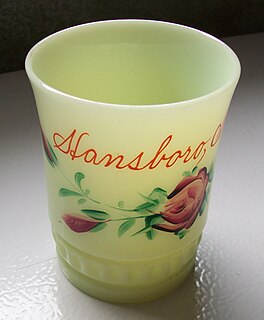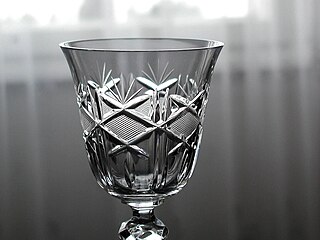Related Research Articles

Glassblowing is a glassforming technique that involves inflating molten glass into a bubble with the aid of a blowpipe. A person who blows glass is called a glassblower, glassmith, or gaffer. A lampworker manipulates glass with the use of a torch on a smaller scale, such as in producing precision laboratory glassware out of borosilicate glass.

Studio glass is the modern use of glass as an artistic medium to produce sculptures or three-dimensional artworks. The glass objects created are intended to make a sculptural or decorative statement. Though usage varies, the term is properly restricted to glass made as art in small workshops, typically with the personal involvement of the artist who designed the piece. This is in contrast to art glass, made by craftsmen in factories, and glass art, covering the whole range of glass with artistic interest made throughout history. Both art glass and studio glass originate in the 19th century, and the terms compare with studio pottery and art pottery, but in glass the term "studio glass" is mostly used for work made in the period beginning in the 1960s with a major revival in interest in artistic glassmaking.

Wheaton Industries was a long-standing famous manufacturer of glassware and ceramics products in Millville, New Jersey, USA. A spin-off of the original firm adopted the name in 2006.

Blow molding is a manufacturing process for forming and joining together hollow plastic parts. It is also used for forming glass bottles or other hollow shapes.

A glass bottle is a bottle made from glass. Glass bottles can vary in size considerably, but are most commonly found in sizes ranging between about 200 millilitres and 1.5 litres. Common uses for glass bottles include food condiments, soda, liquor, cosmetics, pickling and preservatives. These types of bottles are utilitarian and serve a purpose in commercial industries.

In glassblowing, cane refers to rods of glass with color; these rods can be simple, containing a single color, or they can be complex and contain strands of one or several colors in pattern. Caneworking refers to the process of making cane, and also to the use of pieces of cane, lengthwise, in the blowing process to add intricate, often spiral, patterns and stripes to vessels or other blown glass objects. Cane is also used to make murrine, thin discs cut from the cane in cross-section that are also added to blown or hot-worked objects. A particular form of murrine glasswork is millefiori, in which many murrine with a flower-like or star-shaped cross-section are included in a blown glass piece.

Glass etching, or "French embossing," is a popular technique developed during the mid-1800s that is still widely used in both residential and commercial spaces today. Glass etching comprises the techniques of creating art on the surface of glass by applying acidic, caustic, or abrasive substances. Traditionally this is done after the glass is blown or cast, although mold-etching has replaced some forms of surface etching. The removal of minute amounts of glass causes the characteristic rough surface and translucent quality of frosted glass.

The A.H. Heisey Company was formed in Newark, Ohio, in 1895 by A.H. Heisey. The factory provided fine quality glass tableware and decorative glass figurines. Both pressed and blown glassware were made in a wide variety of patterns and colors. The company also made glass automobile headlights and Holophane Glassware lighting fixtures. The company was operated by Heisey and his sons until 1957, when the factory closed.
The Fostoria Glass Company was a manufacturer of pressed, blown and hand-molded glassware and tableware. It began operations in Fostoria, Ohio, on December 15, 1887, on land donated by the townspeople. The new company was formed by men from West Virginia who were experienced in the glassmaking business. They started their company in northwest Ohio to take advantage of newly discovered natural gas that was an ideal fuel for glassmaking. Numerous other businesses were also started in the area, and collectively they depleted the natural gas supply. Fuel shortages caused the company to move to Moundsville, West Virginia in 1891.
A glossary of terms used in glass art

The influence of the Islamic world to the history of glass is reflected by its distribution around the world, from Europe to China, and from Russia to East Africa. Islamic glass developed a unique expression that was characterized by the introduction of new techniques and the innovation of old traditions.

Sasanian Glass is the glassware produced between the 3rd and the 7th centuries AD within the limits of the Sasanian Empire of Persia, namely present-day Northern Iraq, Iran and Central Asia. This is a silica-soda-lime glass production characterized by thick glass-blown vessels relatively sober in decoration, avoiding plain colours in favour of transparency and with vessels worked in one piece without over- elaborate amendments. Thus the decoration usually consists of solid and visual motifs from the mould (reliefs), with ribbed and deeply cut facets, although other techniques like trailing and applied motifs were practised.

Erwin Eisch is a German artist who works with glass. He is also a painter, draughtsman, and printmaker. With that of his friend and colleague in glass Harvey Littleton, Eisch's work in glass embodies the ideas of the international Studio Glass movement. Along with glass artists Sam Herman and Sybren Valkema, Eisch is considered a founder of studio glass in Europe.
Libbey, Inc., is a glass production company headquartered in Toledo, Ohio. It was originally founded 203 years ago in Cambridge, Massachusetts as the New England Glass Company in 1818, before relocating to Ohio in 1888 and renaming to Libbey Glass Co. After it was purchased in 1935, it operated as part of the Libbey-Owens-Ford company and as a division of the Owens-Illinois glass company until 1993, when it was separated back into an independent company.
Novelty Glass Company of Fostoria was one of over 70 glass manufacturing companies that operated in northwest Ohio during the region's brief Gas Boom in the late 19th century. The company made drinking glasses, bar goods, and novelties. Organization of the firm began late in 1890, with banker Rawson Crocker as president and veteran glass man Henry Crimmel as plant manager. Production started in February 1891. The plant was built on the site of the former Buttler Art Glass Company, which had been destroyed by fire in 1889.
Evidence for early glassmaking in the United States has been found of glassmaking at the English settlement on Jamestown Island, Virginia. While some glass window panes were made there after 1608, most of the windows had been shipped from England.
J. H. Hobbs, Brockunier and Company was one of the largest and best known manufacturers of glass in the United States in the 19th century. Its products were distributed world-wide. The company is responsible for one of the greatest innovations in American glassmaking—an improved formula for lime glass that enabled American glass makers to produce high-quality glass at a lower cost. The firm also developed many of the talented glassmakers that started glass factories in Ohio and Indiana.
Hartford-Empire Co. v. United States, 323 U.S. 386 (1945), was a patent-antitrust case that the Government brought against a cartel in the glass container industry. The cartel, among other things, divided the fields of manufacture of glass containers, first, into blown glass and pressed glass, which was subdivided into: products made under the suction process, milk bottles, and fruit jars. The trial court found the cartel violative of the antitrust laws and the Supreme Court agreed that the market division and related conduct were illegal. The trial court required royalty-free licensing of present patents and reasonable royalty licensing of future patents. A divided Supreme Court reversed the requirement for royalty-free licensing as "confiscatory," but sustained the requirement for reasonable royalty licensing of the patents.
Indiana Glass Company manufactured pressed, blown and hand-molded glassware and tableware for almost 100 years. Predecessors to the company began operations in Dunkirk, Indiana, in 1896 and 1904, when East Central Indiana experienced the Indiana gas boom. The start date for the company is considered 1907, when a group of investors led by Frank W. Merry formed a company to buy the Dunkirk glass plant that belonged to the bankrupt National Glass Company. National Glass was a trust for glass tableware that originally owned 19 glass factories including the plant in Dunkirk. National Glass went bankrupt in 1907, and its assets were sold in late 1908.

Cut glass or cut-glass is a technique and a style of decorating glass. For some time the style has often been produced by other techniques such as the use of moulding, but the original technique of cutting glass on an abrasive wheel is still used in luxury products. On glassware vessels, the style typically consists of furrowed faces at angles to each other in complicated patterns, while for lighting fixtures, the style consists of flat or curved facets on small hanging pieces, often all over. Historically, cut glass was shaped using grinding or drilling techniques applied as a secondary stage to a piece of glass made by conventional processes such as glassblowing. Today, the glass is often mostly or entirely shaped in the initial process by using a mould, or imitated in clear plastic. Traditional hand-cutting continues, but gives a much more expensive product.
References
- ↑ Wilson, Kenneth M. New England Glass and Glassmaking. Corning, NY:Corning Museum of Glass, 1972., p. 273
- ↑ Papert, Emma. The Illustrated Guide to American Glass. New York:Hawthorn Books, 1972 p. 102
- ↑ Watkins, Lura Woodside. American Glass and Glassmaking. New York:Chanticleer Press, 1950., p. 27
- 1 2 Papert, 1972, p. 83
- ↑ McKearin, George S. and Helen McKearin American Glass. New York:Crown Publishing, 1948., p.18
- ↑ Douglas, R.W. and Susan Frank. A history of glassmaking. London and Tonbridge: The Whitefriars Press Ltd., 1972., p.3
- ↑ ”blow molding” Encyclopædia Britannica Online,2010. http://www.britannica.com/EBchecked/topic/70079/blow-molding(retrieved 10/26/2010)
- ↑ Stern, E. Marianne. Roman mold-blown glass: the first through sixth centuries. Rome: L’Erma di Bretschneider, 1995., p. 46
- ↑ Papert, 1972, p.112
- ↑ Watkins, 1950, p.14
- ↑ Papert 1972, p.100
- 1 2 Watkins,1950, p.44
- 1 2 3 Wilson 1972, p.237
- ↑ McKearin, 1948, p.18
- 1 2 3 4 Papert 1972, p.102
- ↑ Watkins, 1950, p. 52
- 1 2 Papert 1972, p.112
- ↑ Watkins, 1950, p.43
- ↑ Watkins, 1950, p.27
- ↑ Watkins, 1950, p.44
- ↑ Papert 1972, p.104
- ↑ Papert 1972, p.83
- ↑ Papert 1972, p.108
- ↑ Papert 1972, p.109
- ↑ Watkins, 1950 p.61
- ↑ Papert 1972, p. 100
- ↑ Whitehouse, David, compiler. Glass: A pocket dictionary of terms commonly used to describe glass and glassmaking. Corning, NY:Corning Museum of Glass, 1993, p. 64
- ↑ Wilson,1972, p.237
- 1 2 Wilson, 1972, p.237
- ↑ Papert, 1972 p.100
- ↑ Lee, Ruth Webb. "Flashback: Blown Molded Glass of New England," American Collector (April 1940) reprinted online in Collectors Weekly (April 1, 2009) http://www.collectorsweekly.com/articles/blown-molded-glass-of-new-england/ (retrieved 10/23/2010)